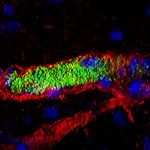Link to Pubmed [PMID] – 17804791
Proc. Natl. Acad. Sci. U.S.A. 2007 Sep;104(37):14783-8
The importance of protein glycosylation in the interaction of pathogenic bacteria with their host is becoming increasingly clear. Neisseria meningitidis, the etiological agent of cerebrospinal meningitis, crosses cellular barriers after adhering to host cells through type IV pili. Pilin glycosylation genes (pgl) are responsible for the glycosylation of PilE, the major subunit of type IV pili, with the 2,4-diacetamido-2,4,6-trideoxyhexose residue. Nearly half of the clinical isolates, however, display an insertion in the pglBCD operon, which is anticipated to lead to a different, unidentified glycosylation. Here the structure of pilin glycosylation was determined in such a strain by “top-down” MS approaches. MALDI-TOF, nanoelectrospray ionization Fourier transform ion cyclotron resonance, and nanoelectrospray ionization quadrupole TOF MS analysis of purified pili preparations originating from N. meningitidis strains, either wild type or deficient for pilin glycosylation, revealed a glycan mass inconsistent with 2,4-diacetamido-2,4,6-trideoxyhexose or any sugar in the databases. This unusual modification was determined by in-source dissociation of the sugar from the protein followed by tandem MS analysis with collision-induced fragmentation to be a hexose modified with a glyceramido and an acetamido group. We further show genetically that the nature of the sugar present on the pilin is determined by the carboxyl-terminal region of the pglB gene modified by the insertion in the pglBCD locus. We thus report a previously undiscovered monosaccharide involved in posttranslational modification of type IV pilin subunits by a MS-based approach and determine the molecular basis of its biosynthesis.

